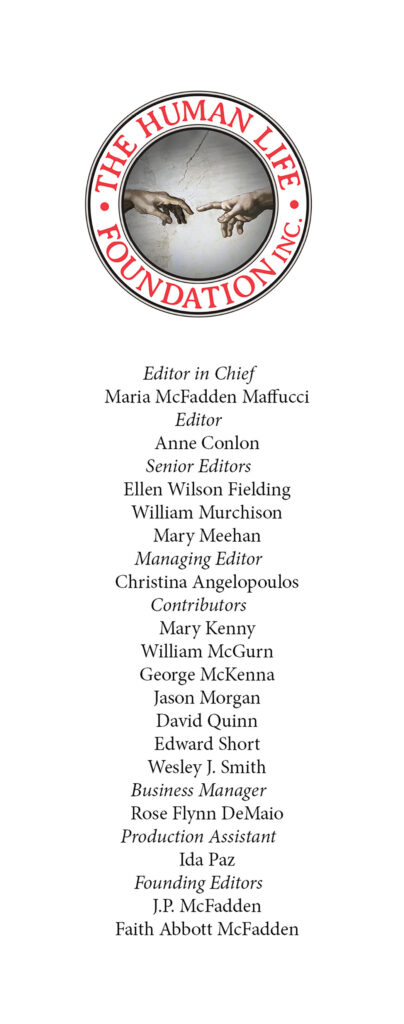| Hover and click over an underlined article to read, or select article below issue!
|
 - from the editor-in-chief . . .
. . . Unsurprisingly, Americans’ trust in the media is at an all-time low. A Gallup poll in October found that only 31 percent had a “great deal” or “fair amount” of confidence in what’s reported in the news. Also not surprising, Democrats tend to trust the news much more than Republicans, which is related to the pro-life movement’s huge challenge in getting our message out. Not only do the “reproductive rights” proponents have the major media’s allegiance, they also have many more times the funds to spend on media buys. In “The Selling of Kate Cox” (p. 72), Julia Duin investigates the press coverage of a woman from Texas who felt “forced” to go to another state to abort her unborn child, who had been diagnosed with Trisomy 18. Duin discovered that those who wrote about the case “never did fact checks about problem pregnancies, never questioned the narrative about aborting fetuses with handicaps, and never bothered to search out opposing points of view.”
But it is not always the “other side,” is it? In our hyper-partisan culture, biased media often manipulate the news to emphasize the faults of the “enemy,” while underplaying the negative news about their own. In “Pope Francis for Life” (p. 5), author Dawn Eden Goldstein points out that Francis was deceptively portrayed by media on both “sides” of the culture wars. His initial comments that “we cannot insist only on issues related to abortion, gay marriage and contraception” became the narrative to describe a progressive pope, while the things he did say about abortion and euthanasia—quite as dogmatic as those of his predecessors—got scant attention. Irish contributor Margaret Hickey agrees: In Appendix B, “Media ‘Gaslighting’ and the Popes,” she writes that the words of Pope Francis and his predecessor were either spun or selectively ignored by the media to serve their agenda.
Civil discussion is our preferred way to ferret out the truth, exemplified in this issue’s symposium, beginning on p. 27. We asked our contributors if the pro-life movement can successfully move forward without explicit belief in God. The 14 responses are fascinating, offering a diverse range of reflections, some on the religious question, some with hard-hitting critiques of the movement and suggestions for how we can do better. Which we welcome! Unflinching truth-telling is the path to progress as well as to a freedom that cannot be stolen. We have such inspiring examples of this in the profiles of the pardoned pro-life rescuers–in John Burger’s “Rescuers will Rescue” (p.16) and in Bernadette Patel’s interview with John Hinshaw, who was incarcerated for 17 months (p.21). You’ll read that, though the rescuers lost their physical freedom, their hearts and souls remained free not only to offer up their sufferings for the unborn, but to minister in mercy to their fellow prisoners.
Please take note of our Great Defender of Life dinner announcement on p.16, and visit our website often for news, Foundation updates, blogs, and pastoral reflections, at www.humanlifereview.com.
Finally, our Review family mourns the death of the vice-chair of our board, Dana Hendershott, whom we remember on p. 80. He was a champion for life who always encouraged us to persevere in hope. As we will, with your support.
Maria McFadden Maffucci
- As I write, news accounts of the pope’s early-morning death on April 21 still ricochet around the internet. This bit from the Wall Street Journal: “Pope Francis, who sought to refocus the Catholic Church on promoting social and economic justice rather than traditional moral teachings . . .” Well, yes, Francis did push for “social and economic justice,” taking a hard line on immigration and the environment. But some of his most startling rhetoric reinforced those “traditional moral teachings,” especially the Church’s hard-line position on abortion. “He made support for the weakest among us the rhetorical centerpiece of his papacy,” the Journal observed in a subsequent editorial. Yes, again, though the writer hardly had the aborted in mind. Our first article, and the column from our website by Margaret Hickey in Appendix B, pay tribute to this outspoken but rarely acknowledged defender of unborn life.
Read More
|
